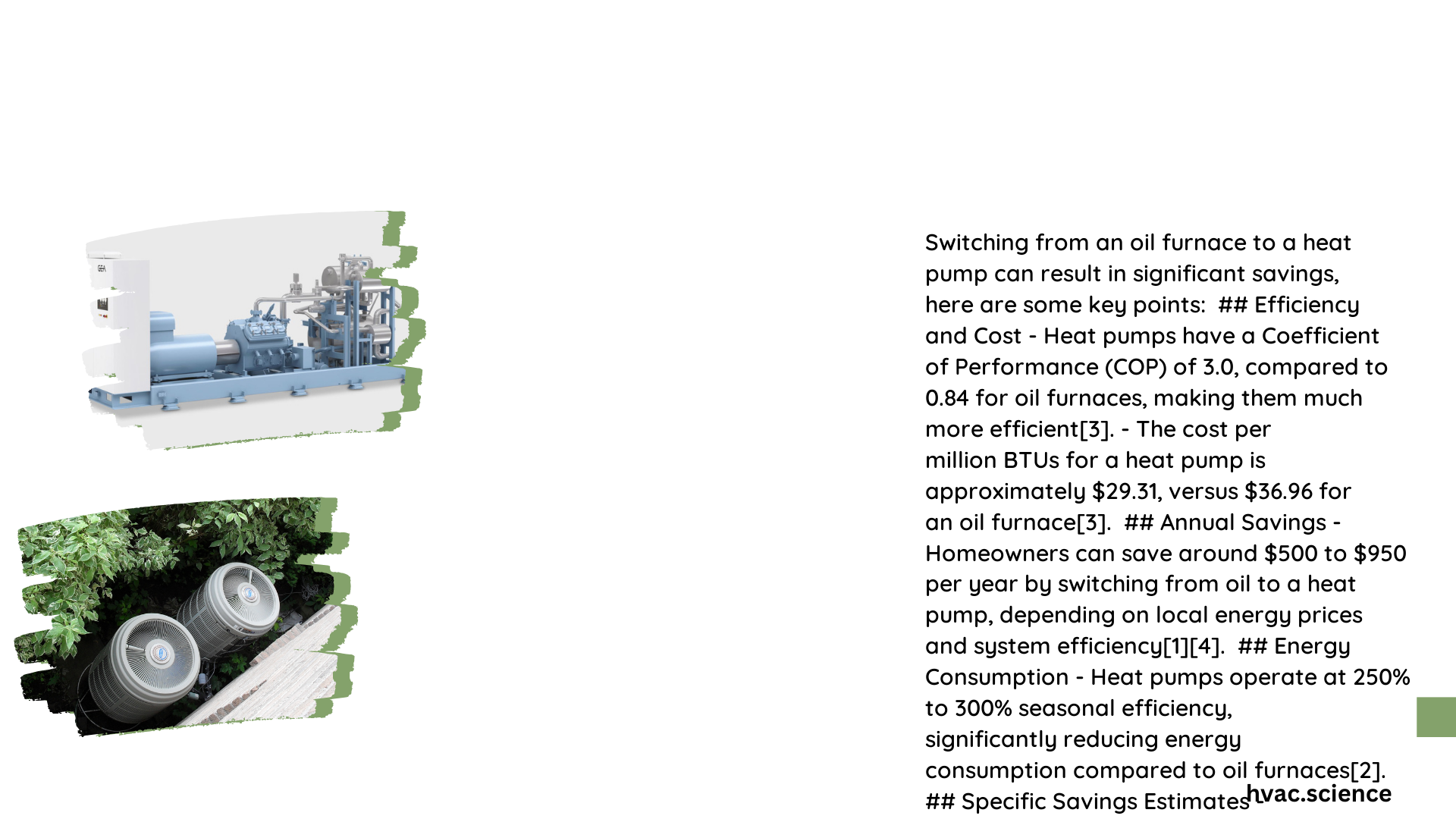Heat pump savings over oil can be substantial, offering homeowners significant long-term financial benefits. By switching from traditional oil heating to a heat pump system, households can reduce their energy consumption, lower their carbon footprint, and enjoy more consistent indoor temperatures. This analysis explores the cost differences, efficiency ratings, and potential savings when transitioning from oil heating to a heat pump system.
What Are the Initial Costs of Heat Pump Installation?
The upfront costs of installing a heat pump system can be higher than maintaining an existing oil heating system. However, various factors influence the overall expense:
- Installation Costs: For a standard 2,000-square-foot home, heat pump installation typically ranges from $12,000 to $16,000.
- Rebates and Incentives: Many regions offer rebates of up to $10,000, significantly reducing the initial investment.
- Existing System: The cost may vary depending on whether you’re replacing an existing system or installing a heat pump in a new construction.
Table: Average Heat Pump Installation Costs
| Factor | Cost Range |
|---|---|
| Base Installation | $12,000 – $16,000 |
| Potential Rebates | Up to $10,000 |
| Net Cost After Rebates | $2,000 – $6,000 |
How Do Operational Expenses Compare Between Heat Pumps and Oil Heating?

The operational costs of heat pumps versus oil heating systems reveal significant differences:
Oil Furnace Costs:
- Consumption: Approximately 7.22 gallons of oil per million BTUs
- Current oil price: $4.30 per gallon
- Cost per million BTUs: $31.05
- Adjusted for efficiency (COP 0.84): $36.96 per million BTUs
Heat Pump Costs:
- Consumption: Approximately 293.1 kWh of electricity per million BTUs
- Current electricity price: $0.30 per kWh
- Cost per million BTUs: $87.93
- Adjusted for efficiency (COP 3.0): $29.31 per million BTUs
Assuming an average annual heating requirement of 50 million BTUs:
– Annual oil heating cost: $1,848
– Annual heat pump heating cost: $1,465.50
Annual Savings: $382.50
What Are the Energy Efficiency Ratings for Heat Pumps and Oil Furnaces?
Energy efficiency is a crucial factor in determining long-term savings:
Heat Pump Efficiency:
- Coefficient of Performance (COP): 3.0
- Heating Seasonal Performance Factor (HSPF): 8 to 12
- Seasonal Energy Efficiency Ratio (SEER): 15 to 20 (for cooling)
Oil Furnace Efficiency:
- Coefficient of Performance (COP): 0.84
The higher COP of heat pumps indicates they are significantly more efficient at converting energy into heat compared to oil furnaces.
How Much Energy Can Be Saved Annually by Switching to a Heat Pump?
Energy savings from switching to a heat pump can be substantial:
- Oil Furnace: Consumes approximately 359.71 gallons of oil for 50 million BTUs of heat
- Heat Pump: Uses about 14,655 kWh of electricity for the same heat output
While these units aren’t directly comparable, the heat pump’s higher efficiency translates to lower overall energy consumption.
What Are the Long-Term Financial Benefits of Heat Pumps?
Long-term savings from heat pumps can be significant:
- Annual Savings: $382.50 based on current energy prices
- 15-Year Savings: $5,737.50, not accounting for potential increases in oil prices
- Break-Even Point: Typically 2-7 years, depending on installation costs and available rebates
List of Additional Long-Term Benefits:
– Reduced maintenance costs
– Potential increase in property value
– Protection against volatile oil prices
– Dual functionality (heating and cooling)
How Do Fluctuating Energy Prices Impact Heat Pump Savings?
The savings potential of heat pumps can increase significantly if oil prices rise:
- Current calculations based on $4.30 per gallon of oil
- If oil prices increase to $5 per gallon, annual savings would grow substantially
- Electricity prices tend to be more stable than oil prices, offering more predictable long-term costs
What Environmental Benefits Come with Heat Pump Installation?
Switching to a heat pump offers several environmental advantages:
- Reduced carbon emissions
- No risk of oil spills or leaks
- Potential use of renewable electricity sources
- Lower overall energy consumption
These environmental benefits may qualify homeowners for additional incentives or tax breaks, further enhancing the financial appeal of heat pumps.
How Can Homeowners Calculate Their Potential Heat Pump Savings?
To estimate potential savings, consider the following factors:
- Local installation costs and available rebates
- Current oil and electricity prices in your area
- Your home’s annual heating requirements
- The efficiency ratings of your current oil furnace and potential heat pump
Example Calculation:
– Installation Cost: $14,000 – $10,000 (rebate) = $4,000 upfront
– Annual Savings: $382.50
– Break-Even Point: Approximately 10.5 years
– Additional Savings: Years 11-15 = $1,912.50
By factoring in these variables, homeowners can make an informed decision about whether switching to a heat pump is financially beneficial for their specific situation.
In conclusion, heat pump savings over oil can be substantial, offering both immediate annual savings and long-term financial benefits. While the initial investment may be higher, the combination of energy efficiency, potential rebates, and environmental benefits make heat pumps an attractive option for many homeowners looking to reduce their heating costs and carbon footprint.
References:
1. https://leblanchvac.com/blog/heating/operating-cost-heat-pump-vs-oil-furnace-or-boiler
2. https://www.modernenergynow.com/which-costs-less-to-run-heat-pumps-or-oil-heat
3. https://jonesservices.com/cost-of-oil-or-gas-heat-vs-heat-pump/
